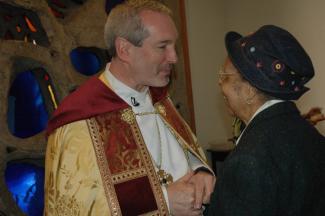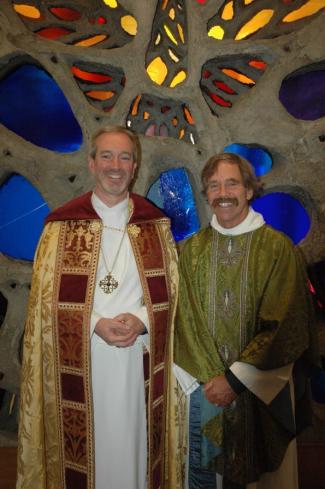A sermon given on Sunday, Sept. 14, 2014, with the Cathedral Congregation of St. Paul, Boston, at the Church of St. John the Evangelist, Bowdoin Street, Boston, by the Rt. Rev. Alan M. Gates, Bishop of Massachusetts. A video of the full sermon may be found here. A printer-friendly PDF may be found at the bottom of the page.
Walking to work a couple of weeks ago, I passed by Faneuil Hall. Sitting on a bench nearby was one of those historic interpreters seen in these parts – a portly man in 18th-century attire, with a brass-buttoned coat, and a pony tail hanging down below his three-cornered hat. It was early enough in the morning that the cobblestone square was not yet full of buskers and visitors. In fact, it was at that moment empty, but for the colonial gentleman on the bench, and me. I nodded to him as I walked by, and to my surprise, he doffed his three-cornered hat in friendly greeting. I thought, “Well, that’s it. I’ve been transported in time, like some episode of Doctor Who, or Bill & Ted’s Excellent Adventure. And here I am with Sam Adams, for heaven’s sake!”
Just then, the colonial gentleman’s cell phone rang. He pulled it from the folds of his frock, and barked a loud hello. The spell was broken. Incongruity had startled me back into the 21st century.
Incongruity of a deeper sort: A slave with a huge debt is ordered by his king to be sold, “together with his wife and children and all his possessions.” The man falls before his master in desperate supplication, pleading for patience. His plea is heard, his debt forgiven. But before we can say ‘Mercy, me!’ that forgiven slave has turned upon a debtor of his own and is utterly heartless. One moment on his knees in seemingly genuine remorse, the next moment gripping his own debtor by the neck in cruel demand. The spell of divine grace is broken. We are startled back into human brokenness by the incongruity between the wicked slave’s posture toward his master and the same man’s posture towards his fellow.
A contrasting tale was heard from the Hebrew Scriptures. Like the wicked slave, the brothers of Joseph fell on their knees in that ancient posture of penitence and supplication. They wept as they acknowledged their crime. But their remorse is proven genuine and enduring. And thus are they recipients of an equally enduring forgiveness.
The incongruity of the wicked slave in the Gospel story is of a different order than that of the colonial re-enacter with his cell phone. Nobody would accuse the man in his tri-cornered hat of hypocrisy. He is just playing a role. But the garment of the slave, the garment of supplication and humility, is meant to be a genuine expression of who he is, not a play-acting costume. That he casts it off so quickly and so thoroughly proves otherwise.
I wonder if you can imagine why these stories have captured my attention and reflection this weekend. Let’s see: clothing that dates to centuries gone by; strange headgear; falling to one’s knees in a posture of dependance and supplication. Such things have been a part of my own story, and our story together, these past few days.
Our church customs are a curious romp across centuries, are they not? Postures of prayer and gestures of supplication which pre-date recorded history. Headgear for bishops that goes back a thousand years. Vestments which echo Roman custom of 2,000 years ago. We worship today in a space which traces its style to principles of the 19th-century Oxford Movement. We worshipped yesterday in a space which traces its style to principles of the 21st-century American athletics. If it made any sense at all to don 1st-century attire in a 21st-century arena, it can only be because we hold to some congruity between the gospel proclamation of that 1st century and the church’s life in the 21st.
The bishop’s mitre is said to represent the shape of the flames of the Holy Spirit. If it makes sense to put such peculiar headgear on bishops, it is only to the extent that we believe, and act to demonstrate, that the Holy Spirit is as active in our day as it was at Pentecost two thousand years ago. If the mitre were an expression of historical practice only, a pointing backward only and not forward – well then, it would be mere costumery and nostalgia, and scarcely worth the cost it took to make it.
No, there must be congruity here. A connection between ancient symbols and contemporary action; a line drawn between the transformation we believe Christ offers and the needs of individuals and the common good, even now; congruity between our peculiar symbols and the life we are striving to live in the world, by God’s grace. The demand for such congruity – between word and deed, between costumery and actual leadership – is a burden which was placed quite literally on my head yesterday. God help me. But I am not alone in this challenge. For such congruity is equally the task of every Christian person. This is your task too. God help us all. As your bishop I expect that you will hold me accountable for fulfilling the vows you heard yesterday. And I expect that as your bishop I will hold you accountable in just the same way.
A priest who puts a stole over her shoulders must do so not only as a sign of her authority, but also as a sign of the burdens she must bear for others in the priestly role.
A believer who makes the sign of the cross must do so not only as a sign that he is claiming God’s blessing or forgiveness, but also as sign that he is prepared to share in Christ’s self-giving sacrifice.
A person who bows her head in prayer must do so not only to enter a moment of pious reverie, but also to express humility before the One upon whose strength she must rely.
If we come into church and kneel before God, you and I, we must also kneel before the image of God in those we encounter when we have left the building. Failure to do so was the sin of the wicked slave in today’s Gospel. Our posture before God must surely be reflected in our posture towards others.
By now perhaps you are thinking: I must be sure to practice as a low-church Protestant Episcopalian, and not an Anglo-Catholic one. Because every vestment and gesture and pious devotion within worship apparently commits me to that much more Christian behaviour outside of worship. Better I should just come in and sit down and not be responsible for all this “congruity” that the preacher is talking about!
(Here I might digress to greet those who worship regularly in this beautiful and venerable Anglo-Catholic space, and to thank you for your hospitality. I greet as well those here this morning from my former parish, St. Paul’s in Cleveland Heights. That church is known for its relative simplicity of architecure and ceremony – so much so that some of my clergy colleauges in Ohio would occasionally refer to the parish as “Mr. Paul’s”! St. Paul’s folks this morning should be advised that the curtained areas in the back corners of this church are confessionals, not coat closets!)
So, we have differences of style, differences of pious practice. But if anyone is thinking from what I said that an elevated level of ceremonial or pious customs commits you to a higher level of Christian behavior, then I have led you astray.
Listen: I have never in 27 years put on my car one of those bumper stickers that has a shiny cross and says “CLERGY” in capital letters. If asked, I will tell you that I wouldn’t want one of those things because I think they are ostentatious, and that I have always suspected that those who display them are more keen to avoid parking tickets than they are to make known their pastoral availability to the drive-by needy. But here is my confession: really, I would never have such a bumper sticker because I don’t want the accountability. What if I want to drive too fast? or yell at some idiot for the way he’s driving? or grab a parking space, quick, before that oncoming car gets it? The sinner in me is frequently manifest behind the wheel of the car, and a “CLERGY” bumper sticker would put way too big a crimp in my style!
Which of course is ridiculous. I am who I am, and what I am, regardless of what my bumper reveals or does not reveal. It’s not a sign affixed to my car that makes me accountable for my behavior, it’s a sign that was once anointed on my head, and a law written on my heart. You and I are who we are, and what we are, regardless of how often or how publicly we bend our knee or recite the Creed, or whether or not we make the sign of the cross, or what we wear on our head or around our neck. Our call to congruity of faith and life was bestowed upon us with the waters of baptism.
But so, thank God, was the grace by which we rise to that call. The very moment we were made accountable to God for living out our baptismal covenant was the moment we were given the strength to do so. Living a life of integrity and congruity is not an easy thing, but it is a thing for which we have been given strength and grace by the same God who asks it of us.
Whatever else you may wear on your head – 3-cornered hat or mitre, rain hat or hard hat, ski cap or graduation cap, Red Sox cap or Cleveland Indians cap – whatever else you may wear on your head, you have on your head the Crown of Life. You wear already if yet unseen the Crown of Life which is promised to every child of God, every inheritor of God’s kingdom. So wear that crown with delight, and by God’s grace, wear it with integrity – living a life worthy of such a garment.


